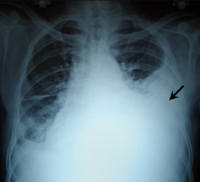
Photo from wikipedia
Introduction: Schwannomas are the most common nerve sheath tumors in the paravertebral mediastinum. Although radiological imaging is helpful in diagnosing schwannomas, a definitive diagnosis is dependent on pathological features of… Click to show full abstract
Introduction: Schwannomas are the most common nerve sheath tumors in the paravertebral mediastinum. Although radiological imaging is helpful in diagnosing schwannomas, a definitive diagnosis is dependent on pathological features of a surgical specimen. For patients who require preoperative diagnosis, an incisional biopsy using minimally invasive surgery is preferred. Endobronchial ultrasound-guided transbronchial needle aspiration (EBUS-TBNA) is less commonly used for suspected schwannomas. Patient concerns: A 48-year-old woman presented to the clinic with complaints of productive cough for >1 month, expectorating yellow and mucoid sputum approximately 4 to 5 times per day. Chest computed tomography revealed a well-circumscribed, homogeneous, soft tissue mass lesion in right upper posterior mediastinum, measuring 55 mm × 44 mm. Vocal fremitus in the right upper lung was diminished, the percussion note was slightly dull, and breath sounds were slightly reduced on auscultation. The patient was a nondrinker and nonsmoker, with no other relevant medical history. There was no significant relevant family medical history. Diagnosis: Complete blood count and blood biochemistry were within normal limits, except for an elevated erythrocyte sedimentation rate (32 mm/h). EBUS-TBNA was performed and histopathological findings were consistent with schwannoma. Interventions: The patient underwent schwannoma excision by thoracoscopy. Pathological findings from the surgical specimen were consistent with the EBUS-TBNA results. Based on EBUS-TBNA and postsurgical pathology, the patient was diagnosed with a right upper mediastinal schwannoma (Antoni B). Outcomes: The patient experienced an uneventful postoperative recovery with no adjuvant therapy and was discharged on April 18, 2017. The patient has been followed up for 4 years and has not experienced any symptoms. Conclusions: Cell blocks obtained from EBUS-TBNA afford the possibility of cytological examination and immunocytochemical staining, which can confirm diagnosis of schwannoma.
Journal Title: Medicine
Year Published: 2022
Link to full text (if available)
Share on Social Media: Sign Up to like & get
recommendations!